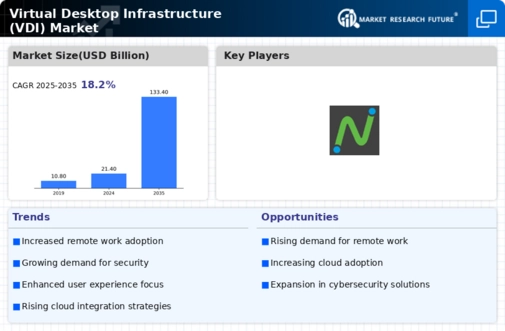Market Trends
Key Emerging Trends in the Virtual Desktop Infrastructure Market
The growing trend of bringing your own device (BYOD) to the workplace allows employees to use their personal devices, even though these devices aren't owned by the company. However, these personal devices must follow the rules and be supervised by the company's IT department. While BYOD can be convenient for employees, it presents certain challenges for organizations. These challenges include making sure employees have the right access to application suites and addressing potential security vulnerabilities. One way to tackle these issues is through virtual desktop infrastructure (VDI), which provides a solution to the challenges posed by BYOD policies. VDI works by giving BYOD users access to virtual desktops. These virtual desktops come equipped with a set of applications that are installed on a virtual desktop computer. This means that employees can connect to these virtual desktops from their personal devices, ensuring proper access to the necessary software. Additionally, VDI helps address security concerns related to personal devices. The IT department takes steps to lock down the virtual machine and ensures it is protected with the latest security software. This ensures that the data and applications accessed through BYOD are secure, even when using personal devices. As companies undergo transformations in their workplaces, many are turning to virtualization as a solution to overcome various challenges. One significant advantage of using virtualization, such as VDI, is the time and effort it saves when upgrading to new platforms or versions of applications. With VDI, the management of the company's IT infrastructure becomes more straightforward, allowing for better control over data and applications within the secure company network. Consequently, the market for VDI is anticipated to experience substantial growth due to the increased demand for workplace flexibility and the resulting productivity benefits for both IT departments and users. In simpler terms, BYOD is a trend where employees use their own devices at work, like personal smartphones or laptops. Even though these devices are not owned by the company, they have to follow the company's rules and be supervised by the IT department. However, this trend comes with challenges for companies, such as making sure employees can access the right software and dealing with potential security issues. Virtual desktop infrastructure (VDI) is a solution to these challenges. VDI allows employees to connect to virtual desktops from their personal devices. These virtual desktops come with a set of applications installed, so employees can use them just like a regular work computer. This helps ensure that employees can access the software they need for their job, even when using their personal devices. VDI also helps address security concerns by securing the virtual desktop with the latest security software. This way, the data and applications accessed through personal devices are kept safe. Many companies are adopting virtualization, like VDI, to solve challenges during workplace transformations. Using virtualization saves a lot of time and effort when upgrading to new technology or software versions. VDI makes it easier for companies to manage their IT infrastructure, allowing better control over data and applications within the company's secure network. This has led to an expected growth in the VDI market because more companies want flexibility in the workplace and the productivity benefits it brings to both the IT department and employees.





Leave a Comment